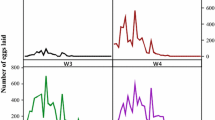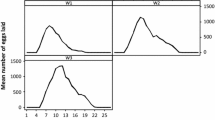Abstract
Amblyomma mixtum is a tick species in the Amblyomma cajennense complex. The known geographic range of A. mixtum extends from Texas in the USA to western Ecuador and some islands in the Caribbean. Amblyomma mixtum is a vector of disease agents of veterinary and public health importance. The objective of this study was to describe the life cycle of A. mixtum under laboratory conditions. Bovines, rabbits and sheep were infested with larvae, nymphs, and adult ticks under controlled conditions to assess several biological parameters. Eggs, larvae, nymphs and adults were kept in an incubator (27 °C temperature and 80% relative humidity) when they were off the host. The average life cycle of A. mixtum was 88 and 79 days when fed on rabbits and cattle, respectively. Sheep were found to be unsuitable because no ticks attached. The rabbit is a more practical host to maintain a colony of A. mixtum under laboratory conditions. The data from this study can be considered as an example for the life cycle of A. mixtum. However, caution must be exercised when making comparisons to the biology of A. mixtum in its natural habitat.
Similar content being viewed by others
References
Allan SA (2014) Tick rearing and in vitro feeding. In: Sonenshine DE, Roe RM (eds) Biology of ticks, 2nd edn. Oxford University Press, New York, pp 445–473. ISBN 978-0-19-974450-3
Almazán C, Torres-Torres A, Torres-Rodriguez L, Soberanes-Cespedes N, Ortiz-Estrada M (2016) Aspectos biologicos de Amblyomma mixtum (Koch, 1844) en el noreste de Mexico. Queh Cient Chiapas 11:10–19
Alonso-Diaz MA, Fernandez-Salas A, Martinez-Ibanez F, Osorio-Miranda J (2013) Amblyomma cajennense (Acari: Ixodidae) tick populations susceptible or resistant to acaricides in the Mexican Tropics. Vet Parasitol 197:326–331. doi:10.1016/j.vetpar.2013.06.004
Alvarez CV, Bonilla MR (2007) Adultos y ninfas de la garrapata Amblyomma cajennense Fabricius (Acari: Ixodidae) en equinos y bovinos. Agron Costarric 31:61–69
Beck DL, Orozco JP (2015) Diurnal questing behavior of Amblyomma mixtum (Acari: Ixodidae). Exp Appl Acarol 66:613–621. doi:10.1007/s10493-015-9928-x
Bouchard K, Wikel S (2005) Care, maintenance and experimental infestation of ticks in the laboratory setting. Biol Dis Vectors 2:705–712
Castro DAM, Garcia SGG, Dzul-Rosado K, Aguilar A, Castillo J, Gabster A, Trejos D, Zavala-Castro J, Bermúdez SEC (2015) Questing Amblyomma mixtum and Haemaphysalis juxtakochi (Acari: Ixodidae) infected with candidatus “Rickettsia amblyommii” from the natural environment in Panama Canal Basin, Panama. Trop Med Health 43:217–222. doi:10.2149/tmh.2015-07
Cooley RA, Kohls GM (1944) The genus Amblyomma (Ixodidae) in the United States. J Parasitol 30:77–111. doi:10.2307/3272571
Drummond RO, Whetstone TM (1975) Oviposition of the cayenne tick, Amblyomma cajennense (F.), in the laboratory. Ann Entomol Soc Am 68:214–216. doi:10.1093/aesa/68.2.214
Estrada-Pena A, Tarragona EL, Vesco U, Meneghi D, Mastropaolo M, Mangold AJ, Guglielmone AA, Nava S (2014) Divergent environmental preferences and areas of sympatry of tick species in the Amblyomma cajennense complex (Ixodidae). Int J Parasitol 44:1081–1809. doi:10.1016/j.ijpara.2014.08.007
Faccini JLH, Cristina BA, Onofrio CVC, Labruna MB, Barros-Battesti DM (2010) The life cycle of Amblyomma auricularium (Acari: Ixodidae) using rabbits (Oryctolagus cuniculus) as experimental host. Exp Appl Acarol 50:71–77. doi:10.1007/s10493-009-9281-z
Garcia MV, Andreotti R, Reis FA, Aguirre AAR, Barros JC, Matias J, Koller WW (2014) Contributions of the hair sheep breed Santa Ines as a maintenance host for Rhipicephalus (Boophilus) microplus (Acari: Ixodidae) in Brazil. Parasites Vectors 7:1–4. doi:10.1186/s13071-014-0515-5
Gerardi M, Martins MM, Nava S, Szabo MPJ (2013) Comparing feeding and reproductive parameters of Amblyomma parvum tick populations (Acari: Ixodidae) from Brazil and Argentina on various host species. Vet Parasitol 197:312–317. doi:10.1016/j.vetpar.2013.06.018
Gonzalez-Ceron F, Becerril-Perez CM, Torres-Hernandez G, Diaz-Rivera P (2009) Ticks infesting body regions of tropical milking criollo cattle in Veracruz, Mexico. Agrociencia 43:11–19
Guglielmone AA, Nava S (2006) Las Garrapatas Argentinas del Genero Amblyomma (Acari: Ixodidae): Distribucion y hospedadores. RIA 35:133–153
Guzman-Cornejo C, Robbins RG, Guglielmone AA, Montiel-Parra G, Perez TM (2011) The Amblyomma (Acari: Ixodida: Ixodidae) of Mexico: Identification keys, distribution and hosts. Zootaxa 2998:16–38
Hooker WA, Bishopp FC, Wood HP (1912) The life history and bionomics of some North American ticks. Bur Entomol Bull 106:72–87
Illoldi-Rangel P, Rivaldi CL, Sissel B, Fryxell RT, Gordillo-Perez G, Rodriguez-Moreno A, Montiel-Parra P, Sánchez-Cordero V, Sarkar S (2012) Species distribution models and ecological suitability analysis for potential tick vectors of lyme disease in Mexico. J Trop Med 2012:1–10. doi:10.1155/2012/959101
Koch CL (1844) Systematische Übersicht über die ordnung der zecken. Arch Naturg 10:217–239
Labruna MB, Pinter A, Teixeira RHF (2004) Life cycle of Amblyomma cooperi (Acari: Ixodidae) using capybaras (Hydrochoerus hydrochaeris) as hosts. Exp Appl Acarol 32:79–88. doi:10.1023/B:APPA.0000018228.05088.26
Labruna MB, Terassini FA, Camargo LM (2009) Notes on population dynamics of Amblyomma ticks (Acari: Ixodidae) in Brazil. J Parasitol 95:1016–1018. doi:10.1645/GE-1878.1
Lisboa CML, Leite RC, Labruna MB, Oliveira PR, Borges LMF, Rodrigues ZB, Carvalho HA, Freitas CMV, Júnior CRV (1998) Host specificity of Amblyomma cajennense (Fabricius, 1787) (Acari: Ixodidae) with comments on the drop-off rhythm. Mem Inst Oswaldo Cruz 93:347–351. doi:10.1590/S0074-02761998000300014
Meng H, Xu S, Yu Z, Liu Z, Liu J, Yang X, Liu J (2014) The life cycle and occurrence of Haemaphysalis concinna (Acari: Ixodidae) under field conditions. Ticks Tick Borne Dis 5:887–891. doi:10.1016/j.ttbdis.2014.07.007
Nava S, Guglielmone AA, Mangold AJ (2009) An overview of systematics and evolution of ticks. Front Biosci 14:2857–2877. doi:10.2735/3418
Nava S, Beati L, Labruna MB, Caceres AG, Mangold AJ, Guglielmone AA (2014) Reassessment of the taxonomic status of Amblyomma cajennense (Fabricius, 1787) with the description of three new species, Amblyomma tonelliae n. sp., Amblyomma interandinum n. sp. and Amblyomma patinoi n. sp., and reinstatement of Amblyomma mixtum Koch, 1844, and Amblyomma sculptum Berlese, 1888 (Ixodida: Ixodidae). Ticks Tick Borne Dis 5:252–276. doi:10.1016/j.ttbdis.2013.11.004
Olegario MMM, Gerardi M, Tsuruta SA, Szabo MPJ (2011) Life cycle of the tick Amblyomma parvum Aragao, 1908 (Acari: Ixodidae) and suitability of domestic hosts under laboratory conditions. Vet Parasitol 179:203–208. doi:10.1016/j.vetpar.2011.01.056
Parola P, Christopher D, Paddock CD, Raoult D (2005) Tick-borne rickettsioses around the world: emerging diseases challenging old concepts. Clin Microbiol Rev 18:719–756
Prata AMC, da Silva LA, Sanavria A (1996) Parâmetros biológicos do estagio ninfal de Amblyomma cajennense (Fabricius, 1787) (Acari: lxodidae) em coelhos. Rev Bras Ciênc Vet 3:55–57. doi:10.4322/rbcv.2015.045
Ramos VN, Piovezan U, Franco AHA, Rodrigues VS, Nava S, Szabo MPJ (2016) Nellore cattle (Bos indicus) and ticks within the Brazilian Pantanal: ecological relationships. Exp Appl Acarol 68:227–240. doi:10.1007/s10493-015-9991-3
Rodriguez-Vivas RI, Perez-Cogollo LC, Rosado-Aguilar JA, Ojeda-Chi MM, Trinidad-Martinez T, Miller JR, Li AY, de León AP, Guerrero F, Klafke G (2014) Rhipicephalus (Boophilus) microplus resistant to acaricides and ivermectin in cattle farms of Mexico. Braz J Vet Parasitol 23:113–122. doi:10.1590/S1984-29612014044
Rodriguez-Vivas RI, Apanaskevich DA, Ojeda-Chi MM, Trinidad-Martinez I, Reyes-Novelo E, Esteve-Gassent MD, de León AAP (2016) Ticks collected from humans, domestic animals, and wildlife in Yucatan, Mexico. Vet Parasitol 215:106–113. doi:10.1016/j.vetpar.2015.11.010
Sanavria A, Prata MCA (1996) Metodologia para colonização do Amblyomma cajenennse (Fabricius, 1787) (Acari:Ixodidae) em laboratório. Rev Bras Parasitol Vet 5:87–90
Sonenshine DE, Roe RM (2014) Biology of ticks, 2nd edn. Oxford University Press, Oxford. ISBN 978-0-19-974405-3
Strickland RK, Gerrish RR, Hourrigan JL, Schubert GO (1976) Ticks of veterinary importance. U.S. Government Printing Office, Washington
Szabó MPJ, Mukay LS, Rosa PCS, Bechara GH (1995) Differences in the acquired resistance of dogs, hamsters and guinea pigs to repeated infestations with adults ticks Rhipicephalus sanguineus (Acari:Ixodidae). Braz J Res Anim Sci 32:43–50. doi:10.11606/issn.0000-0000.32143-50
Szabó MPJ, Pereira LF, Castro MB, Garcia MV, Sanches GS, Labruna MB (2009) Biology and life cycle of Amblyomma incisum (Acari: Ixodidae). Exp Appl Acarol 48:263–271. doi:10.1007/s10493-008-9234-y
Tarragona EL, Mangold AJ, Mastropaolo M, Guglielmone AA, Nava S (2015) Ecology and genetic variation of Amblyomma tonelliae in Argentina. Med Vet Entomol 29:297–304. doi:10.1111/mve.12110
Thangamani S, Bente D (2014) Establishing protocols for tick containment at biosafety level 4. Pathog Dis 71:282–285. doi:10.1111/2049-632X.12187
Troughton DR, Levin ML (2007) Life cycles of seven Ixodid tick species (Acari: Ixodidae) under standardized laboratory conditions. J Med Entomol 44:732–740. doi:10.1093/jmedent/44.5.732
Yu Z, Zheng H, Chen Z, Zheng B, Ma H, Liu J (2010) The life cycle and biological characteristics of Dermacentor silvarum Olenev (Acari: Ixodidae) under field conditions. Vet Parasitol 168:323–328. doi:10.1016/j.vetpar.2009.11.010
Acknowledgements
To the Coordenação de Aperfeiçoamento de Pessoal de Nível Superior (Capes), Conselho Nacional de Desenvolvimento Científico e Tecnológico (CNPq), Fundação de Apoio ao Desenvolvimento do Ensino, Ciência e Tecnologia do Estado de Mato Grosso do Sul (Fundect, MS) - Governo do Estado de Mato Grosso do Sul, Embrapa Gado de Corte, Instituto Nacional de Investigaciones Forestales Agricolas y Pecuarias (INIFAP-Mexico), and Consejo Nacional de Ciencia y Tecnologia (CONACyT) for financial support of the project, USDA is an equal opportunity provider and employer.
Author information
Authors and Affiliations
Corresponding author
Ethics declarations
Conflict of interests
The authors declare to have no conflict of interest.
Rights and permissions
About this article
Cite this article
Piña, F.T.B., da Silva Rodrigues, V., de Oliveira Souza Higa, L. et al. Life cycle of Amblyomma mixtum (Acari: Ixodidae) parasitizing different hosts under laboratory conditions. Exp Appl Acarol 73, 257–267 (2017). https://doi.org/10.1007/s10493-017-0178-y
Received:
Accepted:
Published:
Issue Date:
DOI: https://doi.org/10.1007/s10493-017-0178-y




